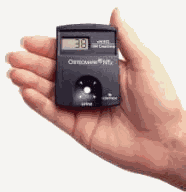 |
Courtesy of Ostex International. |
The U.S. Food and Drug Administration (FDA) has recently granted regulatory approval to a new device that allows patients with osteoporosis to quickly determine whether their treatment is working. Patients use a hand-held disposable device called the Osteomark NTx Point-of-Care to measure their bone loss (bone resorption changes) to make sure they are not losing too much bone. Prior to the FDA’s recent regulatory approval, the device was only available in physician offices. Now, the manufacturer expects to make the device available by prescription to osteoporosis patients later this year.
Osteoporosis is a degenerative bone disease that primarily affects post-menopausal women. It is estimated that one in two women over 50 will have an osteoporosis-related fracture. Literally meaning "porous bone," osteoporosis is characterized by a decrease in normal bone density due to the loss of calcium and collagen. A loss of bone density causes bones to become brittle, and in turn, leads to frequent fractures and other serious effects. There are several options available to help prevent or treat osteoporosis in patients with low bone density. These include hormone replacement therapy, and other drugs such as Fosamax (generic name, alendronate), Evista (raloxifene), Actonel (risedronate sodium), and Miacalcin (calcitonin).
Patients with or at risk for osteoporosis are diagnosed with bone mineral density tests at their physician’s office with x-rays (such as DEXA), CT scans (Osteo CT or QCT) and/or ultrasound. If patients are found to have low bone mineral density, they are usually advised to begin treatment with medications and/or maintain a diet rich in calcium and vitamin D. All women 65 years of age and older should have a bone mineral density test and younger women with one or more risk factors for osteoporosis may also need the test. Only a bone mineral density test can determine whether a patient is at risk for a fracture and osteoporosis.
The new at-home device can help patients with osteoporosis learn whether their treatment is working or whether they may need to change to another treatment. The single-use test, which will be available in the near future at U.S. pharmacies by prescription, will retail for approximately $38, according to its manufacturer, Ostex International, Inc.
The device measures the level of a protein fragment called NTx which is a byproduct of bone matter found in the urine. By determining the amount of NTx in the urine, patients will be able to learn if they are losing too much bone. Physicians and instructions included with the device will help patients learn how to use the test and interpret the results. Results are available within five minutes of use and can be used within three months after treatment has begun. Proctor & Gamble has been using the device in Europe in clinical trials of its osteoporosis drug Actonel, a drug used to prevent or treat osteoporosis.
Osteoporosis is a threat to 28 million Americans and is currently one of the most under-diagnosed and under-treated disorders in medicine. An estimated 1.5 million fractures can be attributed to osteoporosis each year.
Risk factors for osteoporosis include:
- Female gender
- Advancing age, especially the onset of menopause
- Race (Asian and Caucasian)
- Thin build or small body frame
- Low calcium intake
- Lack of physical activity
- History of broken bones
- Certain diseases such as diabetes and kidney or liver diseases
Click here for a full list and explanation of risk factors for osteoporosis.
- The August 15, 2001 Ostex International, Inc. news release, "FDA Grants Rx Home-Use
Clearance for Osteomarkâ NTx Point-of-Care," is available
at http://www.prnewswire.com/cgi-bin/micro_stories.pl?ACCT=152597
&TICK=OSTX&STORY=/www/story/08-15-2001/0001555382&EDATE=Aug+15,+2001 - The Ostex International website provides information on the NTx Point-of-Care device, http://www.ostex.com/
- To learn more about osteoporosis, please visit http://www.imaginis.com/osteoporosis/



